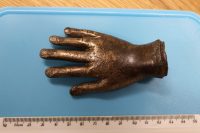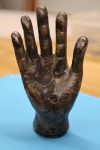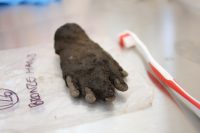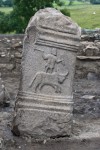 Archaeologists have unearthed a beautifully preserved realistic bronze sculpture of a hand at the Roman fort of Vindolanda in Northumbria. Working with a team of volunteers, Vindolanda’s archaeologists found the hand five feet under ground level in ditch fill from the Severan period (ca. 208-212 AD). The child-sized hand, less than four inches long, had been discarded in the ditch and was caked was dirt.
Archaeologists have unearthed a beautifully preserved realistic bronze sculpture of a hand at the Roman fort of Vindolanda in Northumbria. Working with a team of volunteers, Vindolanda’s archaeologists found the hand five feet under ground level in ditch fill from the Severan period (ca. 208-212 AD). The child-sized hand, less than four inches long, had been discarded in the ditch and was caked was dirt.
 When conservators cleaned off the layer of dirt, they found that the hand was of very high quality, finely crafted and believably realistic, especially on the palm side. They also saw that the hand originally had an attachment inserted in the palm. That attachment is lost. It’s likely that whatever was once there was the star of the show, which is why the palm was so well-made. A socket at the base of the hand suggests it was not broken off of a statue, but rather a stand-alone piece originally fixed to a pole.
When conservators cleaned off the layer of dirt, they found that the hand was of very high quality, finely crafted and believably realistic, especially on the palm side. They also saw that the hand originally had an attachment inserted in the palm. That attachment is lost. It’s likely that whatever was once there was the star of the show, which is why the palm was so well-made. A socket at the base of the hand suggests it was not broken off of a statue, but rather a stand-alone piece originally fixed to a pole.
 The find site is close to the remains of a shrine to Jupiter Dolichenus that were found in the northern wall of the of the 3rd century fort during a 2009 excavation. Archaeologists believe the hand was connected to the temple, serving a votive function associated with the worship of Jupiter Dolichenus. Votive hands have been found at or near other Jupiter Dolichenus temples. They were bigger, however, and several had inscriptions referring to the deity which made their votive role clear.
The find site is close to the remains of a shrine to Jupiter Dolichenus that were found in the northern wall of the of the 3rd century fort during a 2009 excavation. Archaeologists believe the hand was connected to the temple, serving a votive function associated with the worship of Jupiter Dolichenus. Votive hands have been found at or near other Jupiter Dolichenus temples. They were bigger, however, and several had inscriptions referring to the deity which made their votive role clear.
As seen in the altar to Jupiter Dolichenus found in the 2009 of the northern wall, the god is depicted holding a thunderbolt in one hand a double-headed axe in the other. His arm (usually the one holding the axe) is upraised and the votive hands are believed to represent the protection conferred by his power.
Dr Andrew Birley, CEO and Director of Excavations at the Vindolanda Trust commented, “We did not expect to find such a beautifully preserved and rare cult artefact so soon after the start of the 2018 excavation season. When we excavated the nearby temple to Dolichenus in 2009 it was clear that the temple treasures had been removed in Roman times. However, this find being made in a nearby area reminds us that the life of the temple and the practices associated with the worship of Dolichenus had clearly stretched beyond the confines of its stone walls.”
 Founded in Doliche, modern-day Dülük, Turkey, the mystery religion spread throughout the Roman Empire in the early 2nd century, largely thanks to its popularity in the army. It was supported by all the Severan emperors, which is why its popularity plummeted in the mid-3rd century when the last of the Severans, Alexander Severus, was assassinated by the army in 235 A.D. and Maximinus Thrax elected his successor by those same assassins. Thrax came from humble origins and was extremely suspicious that people were out to topple him (they were), so he took action anything and anyone associated with his predecessors. The worship of Jupiter Dolichenus was one of the fatalities.
Founded in Doliche, modern-day Dülük, Turkey, the mystery religion spread throughout the Roman Empire in the early 2nd century, largely thanks to its popularity in the army. It was supported by all the Severan emperors, which is why its popularity plummeted in the mid-3rd century when the last of the Severans, Alexander Severus, was assassinated by the army in 235 A.D. and Maximinus Thrax elected his successor by those same assassins. Thrax came from humble origins and was extremely suspicious that people were out to topple him (they were), so he took action anything and anyone associated with his predecessors. The worship of Jupiter Dolichenus was one of the fatalities.
Cleaned and conserved, the bronze hand has gone on display at the Vindolanda museum in the same gallery as the stone altar.